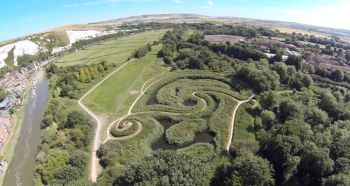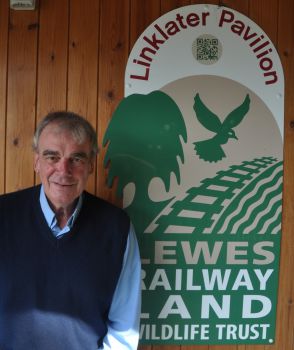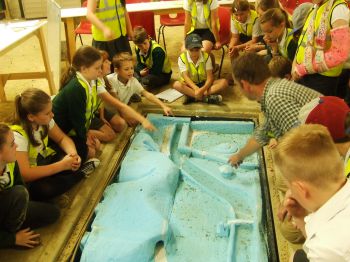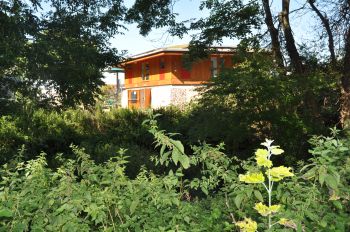Young people play a key role in Lewes’s local nature reserve
Posted on behalf of: University of Sussex
Last updated: Wednesday, 2 August 2017

The Railway Land Nature Reserve is a tranquil spot near to Lewes's town centre.

Dr John Parry was the founder of the Railway Land Wildlife Trust.

Since it was created, the nature reserve has been a place of discovery for hundreds of school children.

The Linklater Pavilion provides a sheltered spot for groups who are visiting the reserve.
Take a stroll through the Railway Land Nature Reserve, a peaceful oasis of woodland and reed beds just a stone’s throw away from the centre of Lewes, and you might think it had been there forever.
In reality the nature reserve was created just thirty years ago, and might not exist at all if it wasn’t for the actions of a few conservationists.
Dr John Parry, who founded the Railway Land Wildlife Trust and who was until recently the Director of the Railway Land Project, recalls the days before mobile phones.
“It was tense at times,” Dr Parry explains. “We set up a phone tree so that we could get people down to the site quickly to protect a particular area, which is now a woodland pond teeming with newts.”
Winning the case for a nature reserve
The struggle to protect the land was led by local campaigners such as the late Elizabeth Howard and John Chaplin.
In 1987, a lawyer called Peter Linklater argued the case for preserving the area at a public inquiry, and won.
These battles were worth it, as the twenty acres of the Railway Land now play home to an astonishing bounty of wildlife.
This peaceful spot is now a favourite haunt for many Lewes residents, including dog walkers and office workers on their lunch break.
The nature reserve has also been a place of discovery for hundreds of local school children over the years.
Dr Parry, a Teaching Fellow in the School of Education and Social Work at the University of Sussex, explains: “The Railway Land is a brilliant space for teaching children about our habitats and ecosystems.
“We are a generation away from people not understanding how the environment works, or where their food comes from. With climate change on the horizon, we need to help the next generation in thinking about their future.
“The nature reserve can be seen as ‘a place to think with’.”
Giving young people a voice
As well as learning about the environment at the Railway Land, young people have also played a crucial role in shaping the reserve and some of the activities that have taken place.
In 1996, the Railway Land became the first local nature reserve to establish a Junior Management Board (JMB), giving local young people a real voice in the decision‑making process.
The award-winning scheme has seen young people taking part in a number of key projects, including designing a logo for the reserve, creating signs for visitors and restoring a woodland pond.
Dr Parry says: “Schools are often focused on getting kids to do exams and jump through hoops – whereas we wanted to give children more control over their learning.
“Schemes like the JMB are vitally important if we want our young people to be able to think outside of the box when they grow up.”
After continuing for a number of years, the JMB has now been succeeded by another initiative involving young people – one that could have an even bigger impact on the town of Lewes.
The Linklater Rats
In 2014, Dr Parry helped to launch a scheme that sees local school pupils taking part in two‑year projects to learn more about climate change and rising water levels in the Ouse Valley.
Children involved in the Linklater Rats (“Raising Awareness of Tides and Sea Levels”) scheme have already built an embankment to prevent erosion at the Railway Land.
The challenge these young people have set to the next group is ‘to research how we can help make the teenage community more aware of what they could do in the event of a flood, and to take any skills they have learned into adulthood’.
Lewes sits on the Ouse floodplain, and on 12 October 2000, the town experienced a devastating flood.
More than 400 homes had to be evacuated and the town centre was submerged, suffering heavy damage. All told, the cost of the clean-up was £88 million.
Dr Parry explains: “Many young people in Lewes saw themselves as victims after the flood of 2000. The Linklater Rats project is a way of helping them to feel empowered.”
A place to learn
In recent years, the nature reserve has gone from strength from strength.
In 2010, the Wildlife Trust celebrated the completion of the Linklater Pavilion, a purpose‑built teaching space at the edge of the reserve.
The Linklater provides a sheltered spot where school groups, as well as adults with learning difficulties, can learn more about the Railway Land and the creatures that live there.
The reserve is run by two part-time staff with the help of volunteers, and recently it has received funding that will allow it to continue its vital work.
It looks like the Railway Land will remain as a tranquil retreat for the people of Lewes – and a ‘place to think with’ – for many years to come.

